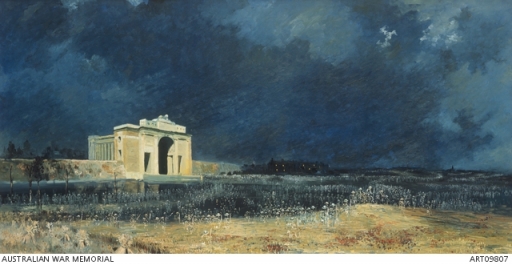CN writer Christopher J. Harvie, considers ‘Menin Gate at Midnight’, the William Longstaff painting on loan to the Canadian War Museum for ‘Fighting in Flanders-Gas. Mud. Memory,’ a Centenary exhibition starting in November 2014.
Together with a pair of statues, known as the Menin Gate Lions, this well known and achingly sombre painting by the Australian war artist, Captain William Frederick Longstaff, has been lent by the Australian War Memorial in Canberra.
Longstaff, who studied at the Heatherley School of Fine Art in London after serving in the South African War was wounded at Gallipoli in 1915 and later attached to 2nd Division, Australian Imperial Force as a war artist. Of his post-war work, the Australian Dictionary of Biography (vol. X,1986) notes he was “best known for his large, popular, allegorical paintings of ghostly fallen soldiers on battlefields…when this painting was exhibited in 1928-29 it created a sensation and reproductions were sold in great numbers. The painting met the need of many at the time to remember those who had died and the contemporary interest in spiritualism.”
Longstaff’s depiction of the Menin Gate memorial with the near visible spectres gathering in the foreground is a poignant expression which links Canada and Australia, and is a bold statement of the war it remembers. Historian and author, Norm Christie, speaking at a recent First World War Symposium in Toronto reminded his audience that “of 70,000 Commonwealth deaths, half have no known grave, and a quarter of that number have not been found.” Part of the melancholy of World War One may not lie in the broader ideals of an inconclusive conflict, but perhaps within the lives of those touched by an individual inconclusive fate.
The Missing remembered
Regardless of known burial or recovered remains, the Commonwealth War Graves Commission (CWGC), with whom Mr. Christie has had extensive experience, was created with the mandate that every man be remembered. To this extent, memorials to the missing were built and dedicated after the war. The Menin Gate is one of four such memorials in Belgian Flanders which cover the area once known as the ‘Ypres Salient.’
The site was particularly chosen because of the hundreds of thousands of men who passed through where it now stands on their way to the battlefields. It is also on the approach to a locality nicknamed ‘Hellfire Corner.’ Nowadays a traffic roundabout just beyond the modern town of Ieper, during the war it was where the Ypres-Menin Road intersected with a railway crossing. Heavily trafficked and under constant German observation and artillery fire, ‘Hellfire Corner’ gained notoriety as the most dangerous place on the Western Front.
Unveiled in July of 1927, the monument was designed by Sir Reginald Blomfield, including sculpture by Sir William Reid-Dick. The Menin Gate bears the names of more than 54,000 officers and men, including almost 7,000 Canadians and 6,000 Australians, whose graves are not known. Some of these men may still lie where they fell in what was once a battlefield a century ago.
Three major battles were fought at Ypres during the First World War. The First Battle of Ypres in October of 1914 was a pivotal battle which shaped the Western Front and, according to the late historian Sir John Keegan “a battle honour that denoted both a crucial success and the destruction of the old regular army.” It was here that the British Army proved critical in stopping the German advance, but to such a great loss on both sides as to inspire the adoption of defensive postures which would remain for most of the remaining four years of war.
2nd Ypres, fought at the end of April 1915 was notable as the first instance of the use of chlorine gas and the stalwart performance of the 1st Canadian Division in its first combat action, which held the line despite confusion, poison, and professional inexperience.
Between July and November of 1917, the Third Battle of Ypres, also known as the battle of Passchendaele was fought. This has gone down in posterity as an exhaustive struggle in the worst possible conditions of heavy rain which pooled in the shattered landscape of shell holes and deep mud. After the British and Australians had suffered a combined loss of more than 100,000, the Canadian Corps took and held Passchendaele by 10 November. Considered a remarkable success, it nevertheless cost the Corps 15,654 casualties, of which 2,600 were fatal.
Lives swallowed
Though it went from being a site of major battles to being viewed at times as a “quiet sector” the Ypres Salient was one place among many along the Front that swallowed lives on a daily basis.
The Menin Gate Memorial, with thousands of names of men not laid to rest, and Longstaff’s painting of two worlds – past and present, ethereal and corporeal – remind us how so many lives were affected and changed in the course of a conflict which is often seen as not having affected or changed very much at all.
Fighting in Flanders – Gas. Mud. Memory. will be on display at the Canadian War Museum from November 7th 2014 to April 26, 2015. To discover more about the Menin Gate Lions, accompanying Menin Gate at Midnight, click here.
© Centenary Digital Ltd & Author
‘Menin Gate at Midnight’ image, courtesy of Australian War Memorial, Canberra
